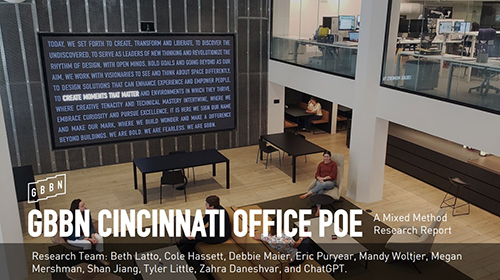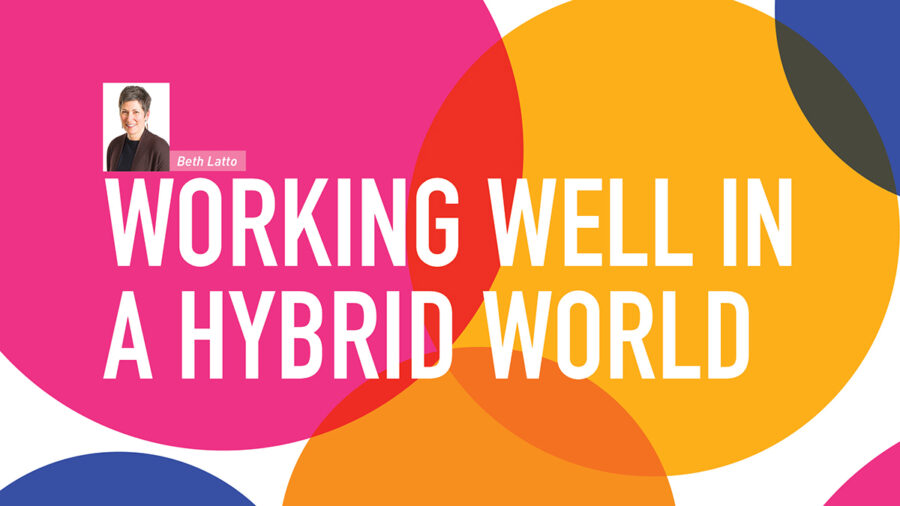Insights
Apr 22, 2024 _ insights
Working Well in a Hybrid World
Advancing technology and the COVID-19 pandemic have changed the workplace and normalized hybrid work. This new lifestyle of work comes with new opportunities and challenges. For many workers, the hybrid life has been hard won. But a hybrid work style can also mean stressors like, which days to go in? Will I overlap with my managers? Am I getting the mentoring I need to advance? As business reporter Emma Goldberg told The New York Times’ The Daily podcast, “It’s an awkward middle we’re in. You want those exchanges with colleagues, you don’t want to be stuck at home forever, but we’ve also gotten used to new ways of working.”
How can physical space support productivity, mentoring, employee satisfaction, and bridge the digital divide that comes with hybrid work? We put our own Cincinnati office renovation under the microscope to get some insight.
The renovations to our Cincinnati office were designed before COVID-19, constructed during lockdown, and have been put to the test with a post-pandemic hybrid workstyle (How hybrid are we? Post renovation, the in-office work rate for our Cincinnati office is between 59%-83% for a non-holiday work week). A recent Post Occupancy Evaluation (POE) of our renovated Cincinnati office offers an interesting look into how these spaces are performing. What’s working as, better, or differently than we anticipated? What needs adjusting? What lessons are we taking away as we work with clients to address their needs today, and into the future?
![]()
We test and re-test; mockup and model; collaborate, learn, and pivot. Our POE used a tool kit—a combination of quantitative and qualitative data collection, research, observation, and surveys. We used walk-n-talk interviews to hear how our employees are using these spaces (and how they really feel about them).
We do this kind of research to help ourselves and our clients understand how space can impact workplace culture and productivity. We want to better understand the common drivers of successful workplaces and what elements help bring the unique spirit of a company into physical form. Ultimately, we want to help our clients make the most impact with their design budgets.
We wanted to share a few takeaways from this POE because we know many organizations find it challenging to surface the best use of their workspace in the new hybrid reality. Below are a few common struggles companies are facing as they adapt their workplaces:
OUR POE REVEALED: Smaller rooms have higher occupancy; meeting rooms designed for 6-8 people typically host only 2-3 people in person (with the remainder on Zoom).
INSIGHT: Wide adoption of video conferencing has enabled more people to fit in smaller rooms. Less physical square feet is needed for conference rooms, but advanced technology is more critical than ever to ensure seamless communication.
THE TAKEAWAY: Large conference rooms can feel unfriendly to video participants because it can be hard to see faces clearly or see who is talking. Participants in the room run the risk of falling into sidebar conversations that leave video participants wondering what’s going on. “Everyone having a square” can feel more equitable for all. Take the money you would have spent on a large conference room and use it to ensure good technology in several, smaller capacity meeting spaces.

OUR POE REVEALED: Collaborative spaces like huddle rooms and café booths garnered positive comments.
INSIGHT: Understanding why employees come into the office can drive the design of collaboration spaces—booths, open and closed huddle spaces, and informal lounges—along with focus spaces, can support employees whether they need heads-down time, in-person connection time, or a little of both!
THE TAKEAWAY: As Gen Z enters the workforce, they are looking for strong mentors and role models to help guide them through their professional lives. “How managers treat team members, bring teams together, and foster collaboration and cooperation will be critical,” says Wendy Hanson, co-founder and chief operating officer of New Level Work, a management coaching service. It’s important to define what productivity means when it comes to being in the office. Beyond “getting things done” (reports, articles, presentations, emails etc.) in-person collaborating, mentoring, and team building helps less experienced employees benefit from the wisdom and skills of seasoned staff.
WHAT OUR POE REVEALED: A dedicated desk isn’t the only way to make a space feel desirable or even customizable: many of our Cincinnati office’s most popular spaces are first come-first served, like the green wall bench in the lobby (people love this for Zoom meetings!) and the café booths. Relaxed meeting spaces that have appropriate tables for laptops are popular.
INSIGHT: Lighting, acoustics, portable technology (like laptop versus desktop computers), furniture and amenities (like access to a kitchen and good coffee) can contribute to making a space feel special, even if no single person owns it.
THE TAKEAWAY: Starbucks doesn’t guarantee regulars the same seat every time, should the workplace? Guaranteeing everyone a dedicated workstation when they’re only coming in 2-3 days a week impacts real-estate costs. Consider using design dollars to offer an experience employees cannot get at home: A framed view, a cozy nook, a green wall, workstations with multiple monitors, areas to make a mess or spread out a big project. Amenities like these can provide employees with a different experience than their at-home workstation.
WHAT OUR POE REVEALED: Varied acoustical environments are critical, but acoustically private doesn’t always mean hidden away. The booths adjacent to our café (a heavily trafficked area) are popular and got high marks for acoustic privacy and focus.
INSIGHT: Different people have different tasks throughout the day. It’s important to provide access to different acoustical environments from social and conversational to muted to distraction free.
THE TAKEAWAY: Mobile technology (like laptops and noise cancelling headphones) and a variety of acoustic environments empower employees to move about and find a space that supports the task at hand (noisy/messy making, collaborative, small huddle, quiet focus etc.).
Whether hybrid work is viewed as a perk or an expectation in your organization may depend on whether an employee entered the workforce pre- or post-COVID. This in turn, can impact employee reaction to your physical space.
“The basket of compensation and benefits has grown,” ADP Chief Economist Nela Richardson told The Business Journals. “Not only can [employers] offer a salary increase, [they] can offer a flexible work arrangement or remote or hybrid work to complete the compensation package.” A new hire looking for a hybrid schedule may be willing to forgo a dedicated desk and work from different areas on days in the office. It’s important to understand how renovations to your physical space could be used to reset expectations.
Read our Cincinnati office post-occupancy study here.

Check out our workplace projects and more workplace insights here, here, and here.
 Beth Latto, NCIDQ, LEED AP, ID+C, WELL AP is a principal and interior designer at GBBN. Beth loves taking a journey with people to understand who they are. Through observing, questioning, and listening, Beth works to thoroughly understand her clients’ needs, and help them envision a future they may not have thought possible. A specialist in workplace strategy, planning, and programming, Beth guides healthcare, nonprofit, and corporate clients through transformative workplace projects.
Beth Latto, NCIDQ, LEED AP, ID+C, WELL AP is a principal and interior designer at GBBN. Beth loves taking a journey with people to understand who they are. Through observing, questioning, and listening, Beth works to thoroughly understand her clients’ needs, and help them envision a future they may not have thought possible. A specialist in workplace strategy, planning, and programming, Beth guides healthcare, nonprofit, and corporate clients through transformative workplace projects.





